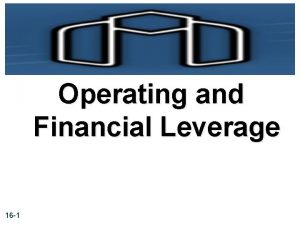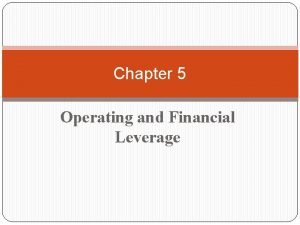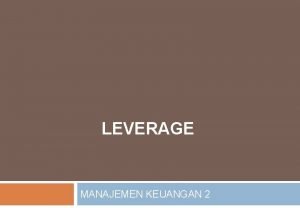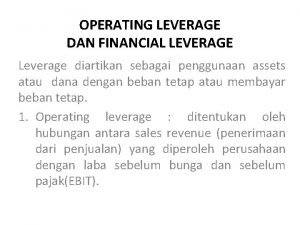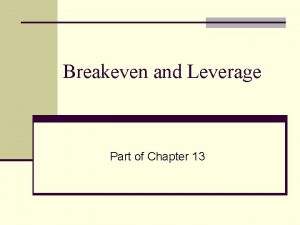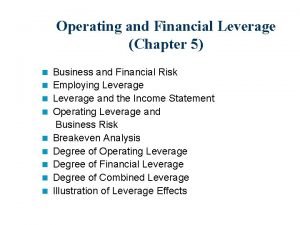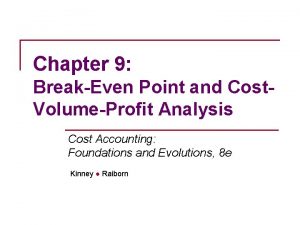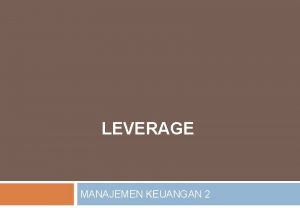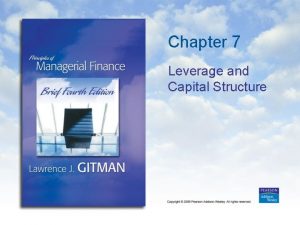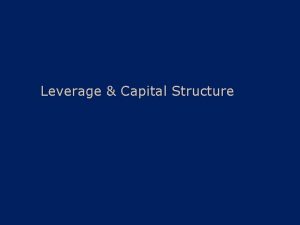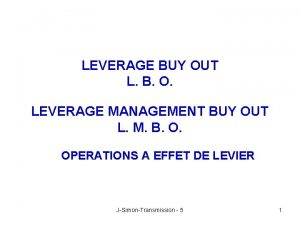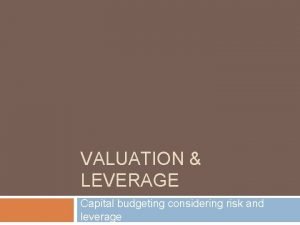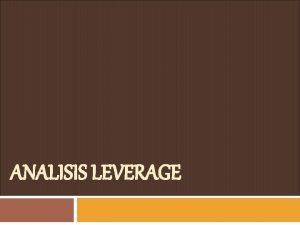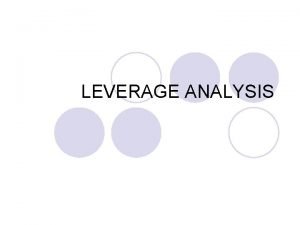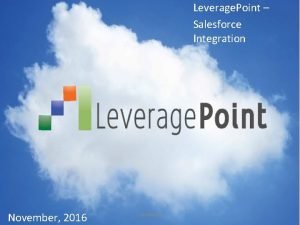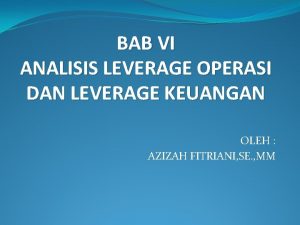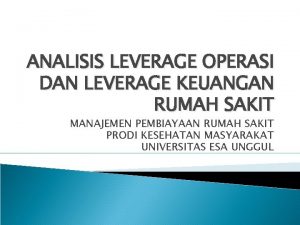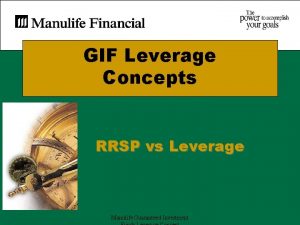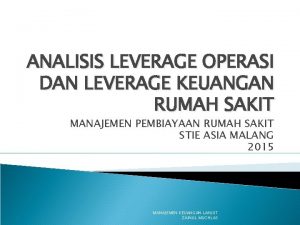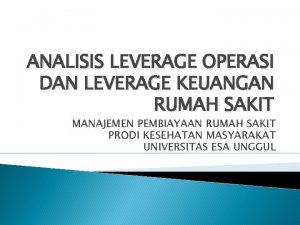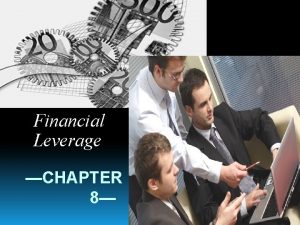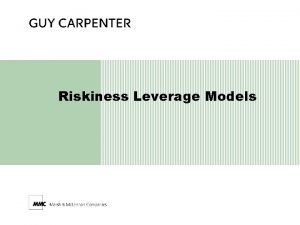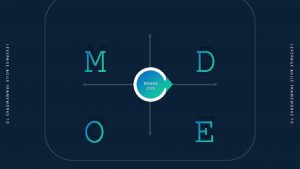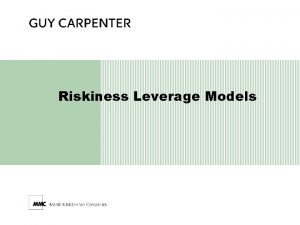Leverage n Operating Leverage n n n The





























- Slides: 29

Leverage n Operating Leverage: n n n The use of fixed operating costs as opposed to variable operating costs A firm with relatively high fixed operating costs will experience more variable operating income if sales change Financial Leverage: n The use of fixed-cost sources of financing (debt, preferred stock) rather than variable-cost sources (common stock) 1

n Leverage Analysis Operating Leverage n n n Affects a firm’s business risk Business risk is the variability or uncertainty of a firm’s operating income (EBIT) Financial Leverage n n Affects a firm’s financial risk Financial risk is the variability or uncertainty of a firm’s earnings per share (EPS) and the increased probability of insolvency that arises when a firm uses financial leverage 2

Breakeven Analysis n n Illustrates the effects of operating leverage Useful forecasting the profitability of a firm, division or product line Useful for analyzing the impact of changes in fixed costs, variable costs, and sales price Terms: n P: price per unit, Q: quantity produced, V: variable costs per unit, VC; total variable costs, F; total fixed costs, TC: total cost (VC+F), S: sales ($) 3

Breakeven Analysis $ Total Revenue (PQ) Quantity 4

Costs n Suppose the firm has both fixed operating costs (administrative salaries, insurance, rent, property tax) and variable operating costs (materials, labor, energy, packaging, sales commissions) 5

Breakeven Analysis Total Revenue $ + } Total Cost (QV)+F or VC+F EBIT FC { Breakeven EBIT Q 1 Quantity 6

Operating Leverage n What happens if the firm increases its fixed operating costs and reduces (or eliminates) its variable costs? 7

Breakeven Analysis With high operating leverage, an increase in sales produces a relatively larger increase in operating income. $ Trade-off: the firm has a higher breakeven point. If sales are not high enough, the firm will not meet its fixed expenses! { FC + Total Revenue } EBIT Total Cost = Fixed - Breakeven EBIT Q 1 Quantity 8

Breakeven Calculations – Quantity 9

Breakeven Calculations – Sales 10

Analytical Income Statement - sales contribution margin variable costs fixed costs operating income (EBIT) interest EBT (1 – t) = Net Income, EBT so, taxes Net Income / (1 – t) = EBT net income } 11

Degree of Operating Leverage (DOL) n n Operating leverage: by using fixed operating costs, a small change in sales revenue is magnified into a larger change in operating income This “multiplier effect” is called the degree of operating leverage 12

Degree of Operating Leverage from Sales Level (S) n Above calculation requires two analytical income statements, one for the base period and one for the following period using the new level of sales 13

Degree of Operating Leverage from Sales Level (S) n n If we have the base level data, we can use this formula: Implicit assumption is that Variable Costs / Sales and Fixed Costs stay the constant If DOL = 2, then a 1% increase in sales will result in a 2% increase in operating income (EBIT) and vice versa %Δ in EBIT = DOLSales x %Δ in Sales 14

Degree of Financial Leverage (DFL) n n Financial leverage: by using fixed cost financing, a small change in operating income is magnified into a larger change in earnings per share (EPS) This “multiplier effect” is called the degree of financial leverage 15

Degree of Financial Leverage n Each financing or capital structure (relative use of debt and equity) alternative will have a different degree of financial leverage (DFL) 16

Degree of Financial Leverage n n Instead of calculating DFL for each alternative capital structure we can use the following formula with the base EBIT and differing interest expenses Note that interest expense would be based on how much debt is used financing the assets of the firm If DFL = 3, then a 1% increase in operating income will result in a 3% increase in earnings per share and vice versa %Δ in EPS = DFLEBIT x %Δ in EBIT 17

Degree of Combined Leverage (DCL) n n Combined leverage: by using operating leverage and financial leverage, a small change in sales is magnified into a larger change in earnings per share This “multiplier effect” is called the degree of combined leverage 18

Degree of Combined Leverage 19

Degree of Combined Leverage n n n If we have the base level data, we can use this formula: If DCL = 4, then a 1% increase in sales will result in a 4% increase in earnings per share %Δ in EPS = DCLSales x %Δ in Sales 20

Example n Based on the following information on a Levered Company, answer these questions: 1) If sales increase by 10%, what should happen to operating income? 2) If operating income increases by 10%, what should happen to EPS? 3) If sales increase by 10%, what should be the effect on EPS? 21

Levered Company – Data Sales (100, 000 units) Variable Costs Fixed Costs Interest paid Tax rate Shares outstanding $1, 400, 000 $800, 000 $250, 000 $125, 000 34% 100, 000 22

Leverage Sales DCL EPS DOL DFL EBIT 23

Levered Company – Base Level Data Sales (100, 000 units) $1, 400, 000 Variable Costs ($800, 000) Fixed Costs ($250, 000) EBIT (Operating Income) $350, 000) Interest paid ($125, 000) EBT $225, 000 Tax @ 34% ($75, 500) EAT (Net Income) $148, 500 EPS = $148, 500 / 100, 000 = $1. 485 24

Degree of Operating Leverage from Sales Level (S) n n n Answer to part 1: %Δ in EBIT = DOLSales x %Δ in Sales %Δ in EBIT = 1. 714 x 10% = 17. 14% 25

Degree of Financial Leverage n n Answer to part 2: %Δ in EPS = DFLEBIT x %Δ in EBIT %Δ in EPS = 1. 556 x 10% = 15. 56% %Δ in EPS = 1. 556 x 17. 14% = 26. 67% (cumulative impact of part 1 26

Degree of Combined Leverage n n Answer to part 3: Alternatively DCL = DOL x DFL DCL = 1. 714 x 1. 556 = 2. 667 %Δ in EPS = 2. 667 x 10% = 26. 67% 27

Levered Company Sales DCL = 2. 667 EPS DFL = 1. 556 DOL = 1. 714 EBIT 28

Levered Company 10% increase in sales Sales (110, 000 units) Variable Costs Fixed Costs EBIT Interest EBT Taxes (34%) Net Income EPS 1, 540, 000 (880, 000) (250, 000) 410, 000 ( +17. 14%) (125, 000) 285, 000 (96, 900) 188, 100 $1. 881 ( +26. 67%) 29
 What is the degree of operating leverage
What is the degree of operating leverage Operating financial leverage
Operating financial leverage Operating and financial leverage
Operating and financial leverage Dol dfl dtl
Dol dfl dtl Rumus dcl
Rumus dcl In the context of operating leverage break even analysis
In the context of operating leverage break even analysis Rumus dfl manajemen keuangan
Rumus dfl manajemen keuangan Degree of operating leverage formula
Degree of operating leverage formula Margin of safety formula units
Margin of safety formula units Thang điểm glasgow
Thang điểm glasgow Thế nào là hệ số cao nhất
Thế nào là hệ số cao nhất Sơ đồ cơ thể người
Sơ đồ cơ thể người Tư thế ngồi viết
Tư thế ngồi viết Cái miệng xinh xinh thế chỉ nói điều hay thôi
Cái miệng xinh xinh thế chỉ nói điều hay thôi đặc điểm cơ thể của người tối cổ
đặc điểm cơ thể của người tối cổ Mật thư tọa độ 5x5
Mật thư tọa độ 5x5 Bổ thể
Bổ thể Tư thế ngồi viết
Tư thế ngồi viết ưu thế lai là gì
ưu thế lai là gì Thẻ vin
Thẻ vin Thể thơ truyền thống
Thể thơ truyền thống Các châu lục và đại dương trên thế giới
Các châu lục và đại dương trên thế giới Từ ngữ thể hiện lòng nhân hậu
Từ ngữ thể hiện lòng nhân hậu Diễn thế sinh thái là
Diễn thế sinh thái là Vẽ hình chiếu vuông góc của vật thể sau
Vẽ hình chiếu vuông góc của vật thể sau Ví dụ về giọng cùng tên
Ví dụ về giọng cùng tên Làm thế nào để 102-1=99
Làm thế nào để 102-1=99 Tỉ lệ cơ thể trẻ em
Tỉ lệ cơ thể trẻ em Chúa yêu trần thế alleluia
Chúa yêu trần thế alleluia Lời thề hippocrates
Lời thề hippocrates

